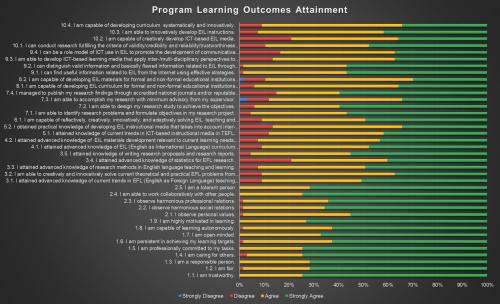Languages
PENGUMUMAN
You are here
The Attainment of PLO
Primary tabs
EXECUTIVE SUMMARY OF
PROGRAM LEARNING OUTCOMES
One of the methods to evaluate the level of attainment toward Program Learning Outcomes in Language Education Science Study Program is using an exit survey. The indicators prioritizing the pedagogic and professional competences based on a humanist and nationalist personality are used as evaluation instrument. With this attempt, the level of attainment for Program Learning Outcomes can be used to support and improve the curriculum which includes: learning outcomes, learning contents, learning processes, and assessment.

- Three-quarters of those surveyed strongly agree with the learning outcomes. They are trustworthy (75%), care (75%), and professionally committed to their tasks (75%). Under these characteristics are highly motivated (73%), fair (72%) and responsible (72%). Over half said they are open-minded (67%), autonomous learners (62.7%), and persistent in achieving learning targets (63%).
- Most of the respondents have ability to work collaboratively (75%) and they are tolerant (72%). Besides, respondents’ observation on personal values, harmonious social and professional relation are varied; those are 55%, 66%, and 64% respectively. Only a few respondents disagree with the learning outcomes (1%).
- Regarding EFL knowledge attained during the study, the survey showed more varied result. Most of the respondents attained knowledge of writing research proposals and reports as evidenced by the least amount of disagreements (4%). In line with this, the respondents also attained advanced knowledge of research methods in English language teaching and learning. The survey result showed high number of agreements (consisting of 43% agree plus 49% strongly agree). The ability to solve EFL problems from inter- and multidisciplinary perspectives is also attained by the respondents as the number of agreements reached 54% supported by 37% strong agreement. More than 90% of the respondents said they attained advanced knowledge of current trends in EFL teaching and learning: around a half said they strongly agreed and 40% said they agreed. Around a fifth of the respondents said they did not attain advanced knowledge of statistics for research, while the majority showed the opposite.
- Most of the respondents attained advanced knowledge of the EIL curriculum (43% agree and 48% strongly agree) and material development (49% agree and 43% strongly agree) relevant to current learning needs, ICT development, and societal developments.
- Returned survey shows 88% (46% agree and 42% strongly agree) of the respondents attained knowledge of current trends in ICT-based instructional media in TEFL. Meanwhile, 12% of the respondents are in disagreement. Over 80% of the respondents obtained practical knowledge of developing EIL instructional media that includes inter-and multi-disciplinary perspectives for formal and/or non-formal educational institutions (52% agree and 34% strongly agree). And only a small minority (13%) of those surveyed disagree with this statement.
- Almost all respondents (42% agree and 49% strongly agree) managed to solve the EIL teaching and learning problems for better instructional practices in a reflective, creative, innovative, and adaptive manner.
- Regarding the research project, the survey shows quite positive results. Just over 90% of the respondents could identify their research problems and formulate their research objectives (39% agree and 57% strongly agree). To achieve these objectives, they were able to design their research study (34% agree and 60% strongly agree). Furthermore, just under 90% of the respondents accomplish their research with minimum advisory from their supervisor (54% agree and 34% strongly agree). In publishing their research findings, the respondents who managed to publish their findings in accredited national and/or reputable international journals reached 85% (25% agree and 60% strongly agree). Only a quarter of those respondents said that they could not manage to publish their research findings in those journals.
- Most of all respondents (58% agree and 36% strongly agree) could develop the EIL curriculum for formal and non-formal educational institutions applying multidisciplinary perspectives meeting the learners’ needs. In line with this, the respondents were also capable of developing EIL materials for formal and non-formal educational institutions applying multidisciplinary perspectives to meet the needs of the curriculum (60% agree and 30% strongly agree).
- About the use of technology, this survey shows quite varied results. Nearly all respondents agree that they can find useful information related to EIL from the internet using effective strategies (42% agree and 57% strongly agree). At the same time, they also managed to distinguish both valid and flawed information about the EIL. More than 80% of the respondents were able to develop ICT-based learning media, which apply inter-/multi-disciplinary perspective, to promote communicative competence, values, and 21st-century skills development (49% agree and 37% strongly agree). Only a small minority (13% disagree) with this. In line with this, the respondents, who stated that they could be role models of ICT use in EIL to promote communicative competence, values, and 21st-century skills, reached 83% (46% agree and 37% strongly agree). Only 16% of the respondents against this.
- For 90% of the respondents managed to fulfill the criteria of validity/credibility and reliability/trustworthiness of their research logically and systematically (42% agree and 48% strongly agree). Meanwhile, 10% of the respondents could not fulfill these. Concerning the ICT-based EIL media development, this survey shows varied results. About 79% of the respondents maintained to creatively develop ICT-based EIL media (43% agree and 36% strongly agree). The respondents who could not perform this were about 21%. Just over 90% of the respondents could develop innovative EIL instructions. Last, this survey shows that almost all respondents (57% agree and 34% strongly agree) could develop curriculum systematically and innovatively.
KONTAK KAMI
PROGRAM PASCASARJANA
Kampus Karangmalang, Yogyakarta 55281
Telp. +62274-550836 (front office)
Fax. +62274-520326
Website : http://pps.uny.ac.id
Email: pps@uny.ac.id, humas_pps@uny.ac.id
Copyright © 2024,
